Peru
South AmericaLevel of surfing
Advanced
Quality of surf
Excellent
Call code
51
Net code
pe
Area
1285220
Coastline
0 km
Climate
Hazards
Severe Storms, Coup / Civil Unrest
Best Months
May - September
Population
28674757
Currency
Nuevo Sol (PEN)
Time Zone
PET (UTC-5)
Special Requirements
Limited Surfing Supplies Available
introduction

Mats Halldin: Map of Peru Bounding box West -82.5°, South -19.5°, East -67.5°, North 1.5°; 20 December 2006
Peru is a country in South America, situated on the western side of that continent, facing the South Pacific Ocean and straddling part of the Andes mountain range that runs the length of South America. Peru is bordered by Ecuador and Colombia to the north, Brazil and Bolivia to the east, and Chile to the south. Peru is a country that has a diversity and wealth little common in the world. The main attractions are their archaeological patrimony (pre-Columbian cultures), their gastronomy (the fifth most important one of the world), their colonial architecture (has imposing colonial constructions) and their natural resources (a paradise for the ecological tourism).
history
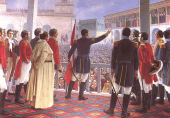
Juan Lepiani: San Martín's proclamation of the independence of Peru on 28 July 1821 in Lima;1904
The earliest evidence of human presence in Peruvian territory has been dated to approximately 11,000 years BCE. The first inhabitants of Peru are believed to have crossed into the Americas during the last Ice Age when lower sea levels exposed a land-bridge that joined the continents of Asia and North America.
Civilization in the Andes has long been equated with the Incas. The architectural achievements of the Incas are inevitably compared to the feats of the Romans.
In contrast, the invasion of the Spaniards in 1532 between the Andeans was one of the first clashes between Western and non-Western civilizations. The Spanish conquest and colonialism has characterized Peru down through the centuries. Peru, like its geography, became divided economically, socially and politically between a semifeudal, largely native coast. The persistence of this "dualism" and the inability of the Peruvian state in more recent times to overcome it have prevented not only the development but also the effective integration of the Peruvian nation to this day.
Another unique feature of Peru is the role that foreigners have played in its history. Peru's independence from Spain in 1824 was largely the accomplishments of "outsiders".
In the early 19th century, while most of South America was swept by wars of independence, Peru remained a royalist stronghold.
During the early years of the Republic, endemic struggles for power between military leaders caused political instability and national identity was forged during this period. Between the 1840s and 1860s, Peru enjoyed stability under the presidency of Ramón Castilla.
However, by the 1870s, these resources had been squandered, the country was heavily indebted, and political in-fighting was again on the rise.
Peru was defeated by Chile in the 1879–1883 War of the Pacific, losing the provinces of Arica and Tarapacá in the treaties of Ancón and Lima.
Internal demographic changes since the middle of the twentieth century have shaped contemporary Peru, including the growth of population.
n 1980, over 60 percent of its work force was located in towns and cities, principally the capital, Lima. In 1985 half of Lima's nearly 7 million inhabitants lived in informal housing, and at least half of the country's population was employed or underemployed in the informal sector.
In 1968, the Armed Forces, led by General Juan Velasco Alvarado, staged a coup against president Fernando Belaunde. The new regime undertook radical reforms aimed at fostering development but failed to gain widespread support. The reform of 1969 destroyed the economic base of both the export elite and the gamonales (rural bosses) in the Sierra. After more than a decade, the military, in public disfavor, returned to the barracks, opening the way, once again, to the democratic process.
During the 1980s, Peru faced a considerable external debt, ever-growing inflation, a surge in drug trafficking, and massive political violence. Under the presidency of Alberto Fujimori (1990–2000), the country started to recover; however, accusations of authoritarianism, corruption, and human rights violations forced his resignation after the controversial 2000 elections. The current president of Peru is Alan Garcíal.
surfing
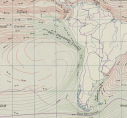
Drawing of Humboldt Current; Unknown US solder
If you are looking for super consistent high quality surf, don't mind cooler water and off beaten track - Peru is the choice. Surf in the area is generated by the WNW, NW, SW and S swells. With northern swells frequenting November to March and southerlies coming through March to November, country is literally blessed with year-round wave selection. Cruise to North swell magnets for NW-SW pulses and South for S-SW. 2400 km of country’s surf susceptible coastline is infested with some excellent waves for all levels of surfing ability. In January-May water temperatures can hit 23 C, with a scope for morning offshores, hot carnival nights and appreciation of exotic South American culture. Peru's surf consists primarily of lefthand rocky and reef breaks, pits, points and slabs, some of them short, square and hollow and others 1000+ m extremely long rides, with Chicama being the most known and busy of locations. One of the explaining factors of amazing swell consistency can be existence of Humboldt (The Peru) current, flowing along the West Coast of South America from south of Chile to the North of Peru, pushing water along the coast, generating 2-3 ft surf and southerly winds.
Travelling to South you are bound to encounter raw power of pumping empty points and beach breaks. Don't forget to grab a decent 4/3 steamer and prepare for long paddles/walks to the points as the currents are strong and walls are long.
The strongest winds occur in the winter months from May-October, while the summer months from November-April have considerably lighter winds. Tidal ranges are up to 6ft with most spots breaking better at low tide.
travel
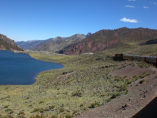
Carlos Rodriga, Ticilio; July 07
It is quite easy to travel to Peru as tourists from North America, Australia, Japan and the European Union (and many others) receive a visa upon arrival for up to 90 days. Upon arrival you will receive an extra official paper to be kept in the passport (make sure you don't lose it!).
As with most of the countries, the easiest way to get to Peru would be by plane. Jorge Chávez International Airport is located in Lima and has frequent flights all over the world. When you leave the country on an international flight be prepared to pay a departure tax, it is about US$25-$30 (around US$6 for the internal flight tax) or the equivalent in soles and has to be payed in cash.
Inside the cities, there is usually no problem getting around on city taxis or buses.
"Taxi" in Peru does not necessarily mean a car; the term also refers to bicycles, motor rickshaws, and motor bikes for hire. You can also catch a train and get around Peru, but be aware that it will slower than the same trip by bus. Though if you are not in a hurry that would be a good thing to do – you will have more time to see what is around and to feel the spirit of the country. And yes, if you are not afraid of being covered by luggage, don’t buy 1st class. But whatever you decided to buy, better do it in advance.
There are no coastal boat services in Peru, but in many areas, water is the obvious means of getting around. There are plenty of smaller boats that will take visitors out to the various islands in the lake. These aren't expensive and a price can usually be negotiated down at the port.
where to stay
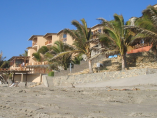
Vivaperucarajo; One of the many resorts in Mancora; November 2006
Low key accommodations (hospedajes) costing around $3-20 are available throughout Peru and might be an interesting way to absorb the local culture, as well as exchange some stories with more adventurous travellers.
However, if intending to stay in a better situated stays with conveniences nearby, prepare to spend around $20-40 a day for a 3 star, while $40+ a day should afford you some luxury.
what to pack
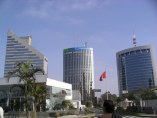
And2000; San Isidro; February 2007
With a long coastline, and plenty breaks to explore it’s a good idea to pack: anti malarials, antiseptic lotions, mosquito repellents sunscreen (SPF 30+), toilet paper, thick socks, good hiking boots and comfortable walking shoes, spare fins, leashes, wax, booties and a good wettie (4/3 for winter).
For the sake of less bites its better to pack light coloured clothes, which won’t save you from mosquitoes, but should attract less. However, avoid extra clothes and any excess of anything, as famous surf destinations have your surf supplies and major cities (e.g. Lima) got westernised malls.
dangers and warnings

When you travel to Peru, be aware of the tropical infectious diseases like malaria, yellow fever and hepatitis which are present in the Amazon Basin and Tumbes (malaria). It is preferable to be vaccinated against yellow fever and malaria if you plan to go there.
Physical violence in Peru is not as extreme in cities such as Rio de Janeiro, Bogotá or New Orleans, but still better be aware of the pickpockets, muggers, bag and watch snatchers, razor-blade pack slashers and confidence tricky. Avoid political gatherings, protests and demonstrations, be especially cautious in crowded areas, on public transport, bus and train stations, and in the centre of Lima at night.
Rules for the women who travel alone do not differ in Peru and are pretty basic as in the most places: avoid dark and isolated areas.
restaurants, shopping and nightlife
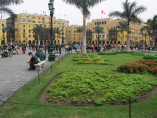
Håkan Svensson; Plaza Mayor in Lima, Peru; July 2004.
You won’t get bored in Peru as you will find so many things to do, see and experience, you may not have enough time to do everything! There is a wide range of bars, cafes and clubs on the cities, especially in Lima. There and in tourist resorts you will find some of the most popular clubs in the country. Where to find information on different venues? Tourist offices in Peru publish an annual and monthly diary of events.
Here are some good restaurants in Lima: Astrid y Gastón, a stylish modern place where you will be served a creative brand of creole-Mediterranean fare (can be called one of the best places in the country); La Hamaca, a mansion where you will find priceless Peruvian art and antiques and spectacularly decorated small dining rooms - you will be impressed; Restaurant Huaca Pucllana, again, one of the best places for a wonderful evening, located within the compound of a 1,500-year-old adobe pyramid! Sounds exciting, ah? The atmosphere there is both hip and relaxed, and you'll be satisfied with the creative Peruvian menu that offers new twists on classic comida criolla (creole cooking). And another place - definitely worth visiting - Las Brujas de Cachiche. Probbably it should be the first place for you to visit as you will find there a spirit of local culture and pre-Columbian Peruvian cuisine with ancient recipes and ingredients. it serves classic Peruvian dishes, such as ají de gallina (chile cream chicken), with innovative twists.
what to do when its flat

Machu Picchu by Beth Mayberry, November 2005
In summer the south beaches of Lima are famous for a vibrant nightlife and huge beach parties. There is a good variety of different restaurants to indulge in. For the days where you decide to do the tourist thing, there are a lot of great activities including, checking out Peru's amazing Inca sites, Parapente (think parachuting from a cliff!) and river kayaking.
The highest navigable lake in the world Located in the southern Andes of Peru, between the borders Peru - Bolivia, the Titicaca is the highest navigable lake in the world, which altitude is 3,812 metres above sea level.
Probably your second step in Peru will be worldwide famous Machu Picchu ruins. They really deserve the visit. No matter how much you have heard or read about it, being there is really unforgettable experience. They are close to Cuzco (2 or 3 hours by train), so you'll have to fly there (buses take up to 30hours!) and dedicate at least a whole day for it. A marvellous way to visit Machu Picchu is doing the Inca Trail, but be prepared, it won’t be that easy! It is a challenging hike. In fact, people say that the Incans made this hike difficult on purpose, for spiritual purification. So it’s definitely worth going.
The most important museum in Lima and perhaps in all Peru, is the Museo de la Nación. This museum is the home for many of country important ancient artefacts. There are scores of mummies, brilliant ceramics and textiles scattered throughout the museum.
useful phrase guide

Hello/Hi (informal) - Hola (OH-lah)
How are you? (informal) - ¿Cómo estás? (KOH-moh ehss-TAHSS?)
Fine, thank you - Muy bien, gracias. (MOOEY BYEHN, GRAH-thyahss)
My name is *** - Me llamo *** (MEH YAH-moh *** )
Nice to meet you - Encantado/a (ehn-kahn-TAH-doh/ehn-kahn-TAH-dah)
It's a pleasure to meet you - Mucho gusto. (MOO-choh GOOST-oh)
Please - Por favor (POHR fah-BOHR)
Thank you - Gracias (GRAH-thyahss)
You're welcome - De nada (DEH NAH-dah)
Yes - Sí (SEE)
No - No (NOH)
Excuse me (getting attention) - Disculpe (dees-KOOL-peh)
Excuse me (begging pardon) - Perdón (pehr-DOHN)
I'm sorry - Lo siento (LOH SYEHN-toh)
Goodbye - Adiós (ah-DYOHSS) / Hasta luego (AHS-tah LWEH-goh)
I can't speak Spanish (well) - No hablo (bien) español (NOH AH-bloh (BYEHN) ehs-pah-NYOL)
Do you speak English? - ¿Habla usted inglés? (AH-blah oos-TEHD een-GLEHSS?)
Is there someone here who speaks English? ¿Hay alguien que hable inglés? (HAHEE AHL-gyen KEH AH-bleh een-GLEHSS?)
Good morning - Buenos días (BWEH-nohss DEE-ahss)
Good afternoon / Good evening - Buenas tardes (BWEH-nahss TAR-dehss)
Good evening / Good night - Buenas noches (BWEH-nahss NOH-chehss)
I don't understand - No entiendo (NOH ehn-TYEHN-doh)
Where is the toilet? - ¿Dónde está el baño? (DOHN-deh ehss-TAH EHL BAH-nyoh?)
Police! - ¡Policía! (poh-lee-SEE_ah!)
Stop! Thief! - ¡Alto, ladrón! (AHL-toh, lah-DROHN!)
I need help - Necesito ayuda. (neh-seh-SEE-toh ah-YOO-dah)
It's an emergency - Es una emergencia. (ehs oo-nah eh-mehr-HEHN-syah)
I need a doctor - Necesito un doctor. (neh-seh-SEE-toh OON dohk-TOHR)
Can I use your phone? - ¿Puedo usar su teléfono? (PWEH-doh oo-SAHR soo teh-LEH-foh-noh?)






